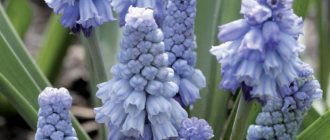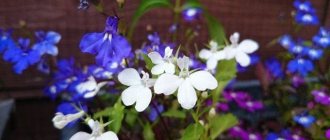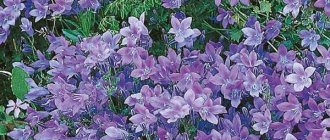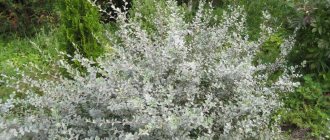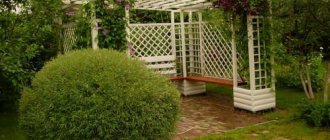Landscape designers love bluebells for their unpretentiousness, high decorative value, ability to grow equally well in the sun and partial shade, and long flowering. Annual, biennial and perennial, they are a wonderful decoration for a flower bed or mixborder. Among its fellows, the crowded bell stands out for its special shape of inflorescences: on each stem there is a dense head, forming a small bouquet containing up to 25 flowers. This is what makes it decorative. And if we add a long flowering period and a good assortment of varieties, it becomes clear that such a plant has a place in every flower garden, especially since planting and caring for bellflowers crowded in open ground is not difficult.
Crowded bell: description
The crowded bell
flower The crowded bell flower (Campanula glomerata) grows in nature in meadows, forest clearings or forest edges, where there is no stagnation of water. Happens quite often. Purple flowers, divided in height into lobes and thirds, are collected in heads at the ends of strong green or brownish pubescent stems with noticeable edges. The height of the stem varies from 20 to 80cm. Sometimes flowers appear in the axils of the leaves - in bunches, but more often they are solitary. Their size is small - up to 2.5 cm, and their shape is star-shaped. The leaves on the stem and at the basal rosette differ:
- at the top they are crenate-serrate, rough or pubescent;
- at the roots - elongated ovoid, and sometimes lanceolate, the base is round or heart-shaped.
The plant is nourished by a thick woody rhizome that goes 30 cm into the ground and produces many adventitious roots. Flowering begins early - already in June and continues almost all summer. In place of the flowers, boxes with medium-sized seeds, up to 1.5 mm, appear with a small lionfish, which helps them spread. The prefabricated bellflower can be called perennial only relatively. Each rosette only lives for one season. Flowering ends with its death and the formation of several new ones, so the crowded bell grows greatly, sometimes becoming aggressive.
Advice ! The plant is not only decorative, but also healing: it has antimicrobial, anti-inflammatory, sedative and analgesic effects. The above-ground part is collected as a medicinal raw material during flowering.
The habitat of the bellflower is Europe, Asia. It was also brought to North America, where it successfully took root. If wild plants are mostly purple in color, very rarely white, then cultivated plants have a great variety of varieties.
Crowded bell: types and varieties
The crowded bell belongs to the genus of bells, represented by only one species, which is divided into a few subspecies. It was introduced into cultivation in 1561, the varieties were obtained by improving wild forms and do not differ too much from them: the size of the flower has increased, new shades have appeared, and the duration of flowering has increased.
The main difference between different varieties of bellflower is the color of the corolla and the height of the plants. Among the kids, the most attractive are:
- crowded bell Gnome or Dwarf - it is not tall, only 20 cm, the small height is compensated by the density of the rosette and the abundant flowering of funnel-shaped purple buds in dense bunches, due to which the plant is very decorative, blooms in June;
- only 5 cm taller than the Gnome is a crowded white bell - Alba, the corollas of snow-white flowers are cut almost in half, so the heads seem fluffy, the variety looks especially advantageous in the company of contrasting flowering plants, decorating a flowerbed in June-July.
Advice ! The variety is suitable for pot culture.
- Flipper rarely grows higher than 25 cm, producing many well-leafed stems, the tips of which are crowned with dark purple flower heads, from June to August, with few axillary flowers;
- bell cluster bellefleur - Bellefleur is presented in two varieties - white and blue, plant height up to 25 cm, flowering from June to August.
Advice ! The flowers stand well as cut flowers.
Tall varieties are no less decorative:
- delicate bluish-lilac flowers of the Caroline variety, the width of the corollas is up to 2 cm, and the height of the plant varies depending on growing conditions from 30 to 60 cm, flowering continues throughout the month of June, the variety is suitable for cutting;
- Superba grows up to 60 cm, its corollas are blue-violet, maximum decorativeness is observed in July;
- the height of the bells of the Freya variety is 50 cm, and the width of the bushes, composed of numerous rosettes with dark green leaves, is up to 40 cm, the corollas of large flowers with a diameter of up to 3 cm are painted light purple, in partial shade it becomes more intense, the greatest decorative effect is in June ;
- in the Emerald variety, gently blue buds open into large flowers with a blue-violet border, the height of the plant is up to 60 cm, it is decorative in June and July;
- the Genti Blue variety has surprisingly bright dark blue large flowers, the compact bush reaches a height of 45 cm, it branches well and attracts bees;
- Prichard's Var has the longest flowering period - from early June to mid-August, the size of the blue-violet corolla is up to 4 cm, the plant height is 60 cm;
- the Speciosa variety has large violet-blue flowers and an openwork bush up to 40 cm high.
The variety of varieties allows plants to find a worthy place in any flower garden or to create a flower bed from just prefabricated bells
Bluebell crowded photo
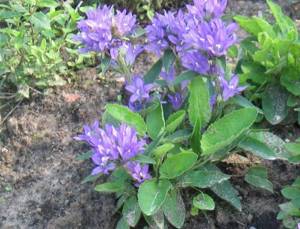
Crowded bell Gnome
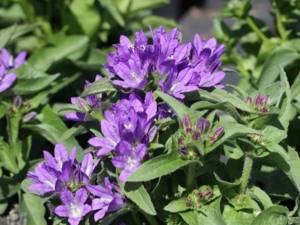
Bluebell crowded belfleur

Campanula crowded Speciosa
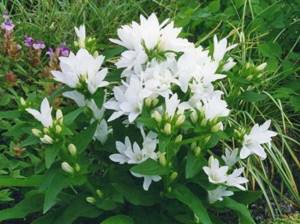
Bluebell crowded Alba
Biennial bells: varieties, planting and care
Also check out these articles
- Aphids on an apple tree
- Description and cultivation of blueberries at home
- Propagation of weigela by cuttings at home
- Treasure of the peatlands
There is a wide range of them on sale now. There are flowers with a simple and double flower shape. They bloom in the 2nd year of life.
Seeds can be planted directly into the ground. To do this, find a shaded place for it, make small grooves (about 0.5 cm), which should be thoroughly compacted after sowing. All that remains is to moisten it, but with a light stream of water, from a spray bottle.
Until the seedlings become stronger, the soil must be kept moist. They are transplanted to a permanent place in August, so that the two-year-old beauties have time to take root well and grow well during the winter.
The bell is medium - biennial. Quite an unpretentious plant. Requires good fertile soil, does not like acidic soils. Moisture-loving. In cold regions it needs to be covered for the winter.
The average one is already a whimsical variety. You should know about this. But their color range is the most diverse.
Bell dotted
This variety will bloom first, in June. Quite large. The dotted bell bush grows up to 60 cm with openwork foliage, fragile shoots and a whole cascade of up to 6 cm long, light purple buds bent down.
And when the bells bloom, there is almost no greenery visible, only densely arranged beautiful flowers. At the peak of flowering, the bush looks stunning; it’s funny to watch how insects and bees crawl into such houses.
Flowering can be extended by removing the already faded dotted bells. After flowering, the bush retains its openwork for a long time. This variety is winter-hardy, shade-tolerant, and prefers light, moist soils.
Campanula latifolia
Broadleaf Fountain is very delicate, with a stunning transparent lavender hue of flowers, surprisingly graceful in shape, forming a spicate, rare raceme. Flowers up to 6 cm long with long pointed teeth looking up.
Broadleaf bell - tall, up to 1 m tall. Looks good either alone or among a group planting.
Young basal shoots begin to appear only in September. This species is shade-tolerant and undemanding to the soil, but does not like transplanting.
Reproduction methods

Bluebell clustered reproduces well, both vegetatively and by seeds. The result is good in all cases.
Seeds
Seeds can be sown immediately in open ground at the beginning of May, and with the early onset of warm weather, at the end of April, also for seedlings. They do this in March.
Advice ! Unlike many other plants, the germination rate of bellflower seeds immediately after ripening is low. The very next year it increases significantly.
How to sow?
In open ground, seeds are sown immediately in place in previously prepared soil in holes about 3 cm deep at a distance of 20 cm. 2-3 seeds are placed in each hole; it will be easier to sow if you mix them with wet sand. The soil must be moist throughout the entire period of germination. When the seedlings grow a little, the extra specimens are planted. You can sow crowded bellflower seeds on a seedling bed with an interval between rows of 20 cm, in a row - 5.
Algorithm for growing seedlings in an apartment:
- prepare light, loose, permeable soil from a mixture of humus, turf soil, coarse sand, taken in a ratio of 3:6:1;
- the mixture is moistened by pouring a slightly pink solution of potassium permanganate;
- the seeds are laid out in rows 2 cm deep, sprinkled with soil, sprayed;
- create greenhouse conditions by placing a plastic bag over the container;
- kept at a temperature of about 20 degrees in the light, but without access to direct sunlight;
- shoots will appear in 2-3 weeks, all this time the crops are regularly sprayed and ventilated;
- the film is removed, the soil is regularly moistened and loosened;
- after about a month, when the third leaf appears on the seedlings, pick into separate containers;
- after two weeks, water with a weak solution of complete mineral fertilizer;
- planted in the ground in early June.
Flowering can be expected already in the year of sowing.
By cuttings
The variety you like can be easily propagated by stem cuttings:
- cut cuttings from young shoots 3 cm long so that each has at least two buds;
- remove a couple of lower leaves, shorten the apical ones by a third;
- dry the sections for half an hour;
- prepare the soil from a mixture of sand and peat in equal parts, fill containers with it or pour it into the cuttings if rooting will take place outside;
- spill the soil with a weak solution of potassium permanganate;
- deepen the cuttings by 1 cm;
- cover with a film draped over the arms or a glass jar if there are few plants;
- periodically sprayed, maintaining high air humidity.
Advice ! If the cuttings are located outside, the rooted material must be shaded from direct sunlight.
The roots appear after 3 weeks, the grown plants are planted in a permanent place.
Dividing the bush
Only adult plants that have reached four years of age can be divided. The procedure is carried out at the beginning of the growing season - in May or at the end of summer.
- The bush is dug up.
- The stems are trimmed and the rhizome is divided with a disinfected sharp knife so that each part contains a developed root with growth buds.
- The cuts are treated with charcoal powder and immediately planted in a permanent place, not forgetting about watering.
Newly planted plants need special care.
Medium bell - detailed description
The middle bell, biennial or campanula is striking in its dissimilarity from other garden plants.
Flowers are popular among gardeners because they do not need to be replanted every year. They are not capricious or whimsical. They reproduce on their own.
Perfect for planting in flowerbeds among annuals, as well as as an independent single seedling on flat surfaces such as a lawn or garden plot.
Unlike annual species, biennials are planted one summer, and the next they delight with their gorgeous flowering.
The two-year-old species does not cause any problems or troubles.
It does not require special care.
Popular types of bells:
- Tall. This flower is ideal for growing both on flat surfaces and in flower beds. Tall crops make beautiful bouquets. It reaches a height of 100 cm.
- Medium height. This biennial flower is very popular. It reaches a height of 70 cm.
- Short. Ideal for growing on borders or alpine hills. Reaches a height of 30 cm.
The medium bell can be recognized by such parameters as: a straight stem with large cups in the shape of a “glass”, which can be of a wide variety of colors. For example, white, pale yellow, blue with a lilac tint.
Campanula can be:
The plant begins to bloom in early summer and continues until early autumn.

The most popular types of bells
Popular types of bells:
- Medium pale ocher or spadefoot
The plant pleases with its flowering from June to August. It can reach a height of 50 to 70 cm. The flower has a large number of pubescent stems. This species is characterized by large ocher-yellow cups. Does well in slightly alkaline soil. It loves light, so the place where it is grown should have good lighting. This variety is grown to decorate a stone garden or monument.
Landing

Growing crowded bellflower begins with planting seedlings.
Selecting a location
The plant feels great in bright sun, it will also grow well in partial shade, although it will bloom a little later, but the color of the inflorescences will be brighter. The main condition when choosing a location is dry soil. The plant does not tolerate stagnation of water at all; the roots rot very quickly. Planting near bushes or trees is undesirable; the crowded bell will lose in the fight for moisture and nutrition. Places with strong winds are also not suitable - he does not like drafts.
Advice ! The darker the leaf color of a variety, the better it tolerates shading.
Soil preparation
Plants are not too demanding on the mechanical composition of the soil and its fertility: loam or sandy loam with a neutral or slightly alkaline soil reaction is suitable. The site is dug up, carefully selecting the rhizomes of perennial weeds, this is especially important if the seeds will be sown directly into the ground. Very poor soils are enriched with a small amount of humus, a little complex fertilizer is added to the hole before planting, mixed with the soil. Heavy clay soil is diluted with humus and sand. Acidic soils are limed.
Advice ! Fresh manure cannot be added when planting; this also applies to peat.
Landing rules
The best time to move seedlings into the ground is the end of May or the beginning of June. Planting a crowded bell is carried out as follows:
- the distance between the holes is chosen depending on the height of the plants: 15 cm - for dwarf varieties, 25 - for medium-sized varieties, 40 - for tall ones;
- the depth of the hole corresponds to the size of the root system - it should not tuck in when planting;
- the plant is carefully lowered into the hole without deepening it;
- The roots are sprinkled with soil, compacted and watered.
Advice ! For better survival, it is better to shade the plants from bright sunlight for the first few days.
Care
Caring for the crowded bell is not difficult - the plant is unpretentious. It consists of ordinary agrotechnical measures.
Watering
The frequency of watering is determined by weather conditions. The plant is drought-resistant; it requires moisture in the heat if there has been no rain for a long time. Water abundantly, but rarely, wetting the entire root layer. The water should be soft, heated in the sun.
Feeding
You need to feed the crowded bell moderately, without getting carried away with nitrogen fertilizers. They are needed only at the beginning of the growing season - no more than 10 g per linear meter. During the period of protrusion of flower stalks, complex mineral fertilizer in the same dosage will be required. Several times a season, before loosening, add a little wood ash under the bushes: it will deoxidize the soil and enrich it with potassium. The last feeding is immediately after flowering with full mineral fertilizer, at which time the flower buds of the next season are laid.
Trimming
Pruning of the crowded bell is carried out in preparation for wintering: the stems are cut flush with the ground. To make the bush look decorative and flowering to last longer, dried flower stalks are removed if seeds are not needed for propagation.
The soil is regularly weeded and loosened.
Preparing the flower Bluebell for winter
Campanula is a winter-hardy plant. It winters successfully in the third climate zone. But frosts can occur even before snow cover sets in. In order not to lose the flower, it is better to mulch it with a layer of compost or humus 15 cm thick, cutting off the above-ground part. This is done after the first autumn frosts. Shelter is especially important for heat-loving varieties.
Plant care
It is not at all difficult to care for a bell in the open ground. The plant can do without watering in the spring months, when the roots receive enough moisture from melt water.
After wintering, the plants should be inspected and dead parts of the bushes should be removed.

To prevent the plant's roots from suffering from the heat, mulch the soil under the bell
During extreme heat, to retain moisture, it is necessary to mulch the soil in the beds with plants. Bluebells that grow on rocky hills do not require mulching in the summer.
Advice! Campanula does not tolerate the proximity of weeds: plant care includes timely weeding and removal of weeds from flower beds.
Diseases and pests
The crowded bell has good immunity, but growing in unsuitable conditions - on heavy soils with close groundwater or in dense shade can lead to fungal diseases:
- Fusarium, in which the root collar and roots rot, the tissues turn brown, and the plant may die; treatment with Fundazol will help;
- if the plant is covered with a white coating, it means it is affected by white rot or sclerotinia, it will have to be removed and the soil dug up;
- gray rot or botrythiosis is manifested by a coating of gray mold; preventive spraying with Bordeaux mixture with a concentration of 1.5% every two weeks will help to cope with it.
The most common pests are leaf beetle caterpillars, slugs and spider mites. If the number is small, use a solution of green soap. If there are a lot of pests, you will have to resort to treatment with insecticides and insectoacaricides.
